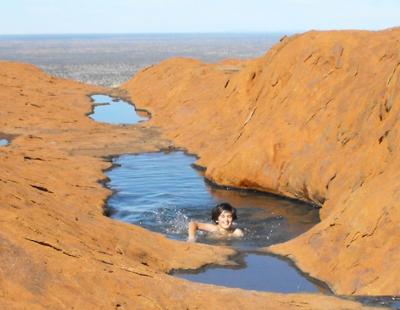Uluru Reviews: This series features reviews and comments about the Uluru Experience. These are the ones you are unlikely to see promoted by Parks Australia.
#2 Beauty, bans, fines, nonsense & superstition... Is it really worth a visit?
This great review by Roy Broff (click on the link) tackles all the hard questions about visiting Uluru:
Getting there The desert is boring and monotonous but at least easy to steer
Impressions of the cultural centre The best thing about the centre is that it has TOILETS
Photography Huge areas of the rock are declared sacred and penalties for photographing such areas ($5000 or 6000) can make you broke in no time – please leave your CAMERA in the car
Here's a comment on Roy's review:
The Summit is Fantastic
Anyone who dismisses the climb as "only a small part" of the experience misses the importance of it to those of us that want to climb it. It is part of the Australian culture to climb such things for many reasons - tradition, family who have done it; life long desire and like Everest "because it is there".
I spoke to over fifty people who climbed the rock the same day I did and all had stories to tell of their dreams of climbing it and how agry it made them that the aborigines seem to close it on a whim. Many were very upset that their children and grandchildren will not be able to climb it. The friendly atmosphere on the climb is fantastic. People who would never normally speak to each other were chatting and offering help and encouragement. It was a wonderful community feel that will be lost.
I spent five hours on the rock and walked out to the far end. I spent about the same walking and driving around the base. The top of the rock is one of the most special and fascinating places in the world and I have been to 35 countries. The walk around the base is but a mere shadow of the walk at the top.
To stop the climb is insensitive and illogical but culture and politics always are. Whose culture is more important? What compromise can/should be made?
If you respect all people. Why do you not respect those who want to climb?
ALL racism. All bigotry is UGLY.
#2 Beauty, bans, fines, nonsense & superstition... Is it really worth a visit?
This great review by Roy Broff (click on the link) tackles all the hard questions about visiting Uluru:
Getting there The desert is boring and monotonous but at least easy to steer
Impressions of the cultural centre The best thing about the centre is that it has TOILETS
Photography Huge areas of the rock are declared sacred and penalties for photographing such areas ($5000 or 6000) can make you broke in no time – please leave your CAMERA in the car
Climbing the climb to the top is seriously discouraged and frequently banned for a range of often ridiculous excuses/conditions (e.g. high winds or temperatures at the summit where there is obviously no anemometer or even a simple thermometer). Failure to comply with the ban shall get you another $5500 fine... SAFETY is very convenient excuse, although the climb to the top is not a big deal for any fit person (I'm 53 and did it "hands-free" – this is no use of hands or chain).
What to do on top We spent a whole day discovering heaps of interesting plants, herbs, animals, birds, bugs, holes, mini-caves, views, waterholes, crevices, rocks, etc. Believe it or not my son swam into some of the waterholes – depths can be more than 2 m. but the water is quite cold!
As Roy says "Swim between the flags"
The future make (the park) a real National (as opposed to the current aboriginal) park & attraction where millions of people from all over the world can worship &/or enjoy whatever they like - nature, Australian (aboriginal & other) culture, lifestyle and have serious fun
Thanks Roy!Here's a comment on Roy's review:
The Summit is Fantastic
Anyone who dismisses the climb as "only a small part" of the experience misses the importance of it to those of us that want to climb it. It is part of the Australian culture to climb such things for many reasons - tradition, family who have done it; life long desire and like Everest "because it is there".
I spoke to over fifty people who climbed the rock the same day I did and all had stories to tell of their dreams of climbing it and how agry it made them that the aborigines seem to close it on a whim. Many were very upset that their children and grandchildren will not be able to climb it. The friendly atmosphere on the climb is fantastic. People who would never normally speak to each other were chatting and offering help and encouragement. It was a wonderful community feel that will be lost.
I spent five hours on the rock and walked out to the far end. I spent about the same walking and driving around the base. The top of the rock is one of the most special and fascinating places in the world and I have been to 35 countries. The walk around the base is but a mere shadow of the walk at the top.
To stop the climb is insensitive and illogical but culture and politics always are. Whose culture is more important? What compromise can/should be made?
If you respect all people. Why do you not respect those who want to climb?
ALL racism. All bigotry is UGLY.

Comments
Post a Comment